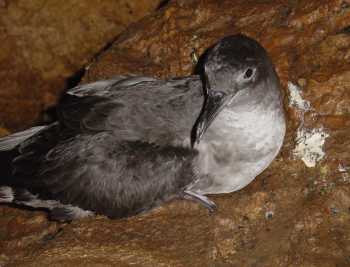Meritxell Genovart (Population Ecology Group, IMEDEA (CSIC-UIB), Esporles, Mallorca, Spain) and colleagues have written in the Journal of Applied Ecology have modelled the demography of the Critically Endangered Balearic Shearwater Puffinus mauretanicus – an ACAP-listed species.

Balearic Shearwater, photograph by Daniel Oro
The paper’s summary follows:
“Worldwide, many seabirds are affected by fisheries in opposing ways: as a source of mortality from bycatch, but also by providing discards as a predictable and abundant food resource. This applies to the Balearic shearwater Puffinus mauretanicus, the most endangered European seabird, whose time to extinction was estimated at only ~40 years a decade ago.
Since the previous assessment, new data and more sophisticated demographic modelling have become available, and new fishing policies from the European Union (Common Fisheries Policy, CFP) will apply, posing different scenarios for the viability of the species. Thus, there is both an urgent need and an opportunity for a more reliable update of the conservation status of the species.
Demographic data were collected between 1985–2014 at one of the world's largest colonies. Most demographic parameters were estimated using multi-event capture–recapture modelling. Some parameters, such as bycatch rate, immature individual survival and recruitment were estimated for the first time. We incorporated estimates into stochastic population models to forecast time to extinction and assess the viability under different management scenarios, accounting for upcoming fishing policies.
Adult survival was much lower than expected (0.809, SE: 0.013), and largely influenced by bycatch, which accounted for a minimum of 0.455 (SE: 0.230) of total mortality. Breeding success was positively correlated with discard availability. Recruitment started at low rates in 3-year-old birds (0.030, SE: 0.0455), increasing in following age classes and was almost complete at 6 years. Under the present scenario, we predict a time to extinction of 61 years (95% CI: 55–69).
Synthesis and applications. Population projections suggest that the actual impact of fisheries on Balearic shearwaters is unsustainable and the imminent discard bans under the new Common Fisheries Policy may accelerate the declining trend. This study demonstrates that reducing the bycatch rates of fisheries is an unavoidable and urgent conservation measure for avoiding the extinction of the species. We also advise setting up demographic long-term studies, to allow researchers to diagnose, with reliability, the effectiveness of management actions. These actions will also benefit many other marine top-predator species affected by this anthropogenic impact.”
Reference:
Genovart, M., Arcos, J.M., Álvarez, D., McMinn, M., Meier, R., Wynn, R., Guilford, T. & Oro, D. 2016. Demography of the critically endangered Balearic shearwater: the impact of fisheries and time to extinction. Journal of Applied Ecology DOI: 10.1111/1365-2664.12622.
John Cooper, ACAP Information Officer, 11 February 2016

 English
English  Français
Français  Español
Español